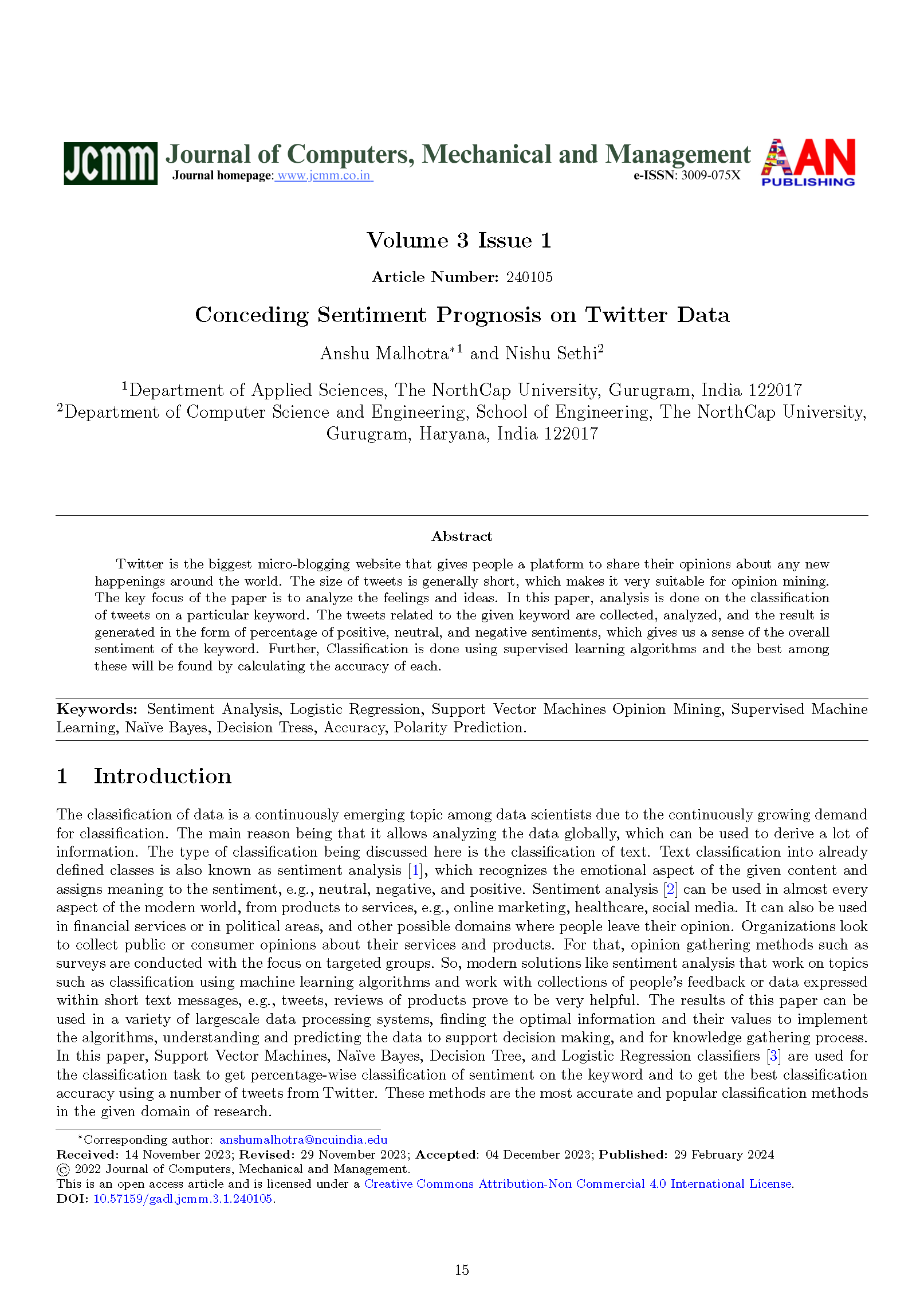Conceding Sentiment Prognosis on Twitter Data
DOI:
https://doi.org/10.57159/gadl.jcmm.3.1.240105Keywords:
Sentiment Analysis, Logistic Regression, Support Vector Machines, Opinion Mining, Supervised Machine Learning, Naïve Bayes, Decision Tress, Accuracy, Polarity PredictionAbstract
Twitter is the biggest micro-blogging website that gives people a platform to share their opinions about any new happenings around the world. The size of tweets is generally short which makes it very suitable for opinion mining. The key focus of the paper is to analyze the feelings and ideas. In this paper, analysis is done on the classification of tweets on a particular keyword. The tweets related to the given keyword are collected, analyzed, and the result is generated in the form of percentage of positive, neutral and negative sentiments, which gives us a sense of overall sentiment of the keyword. Further, Classification is done using supervised learning algorithms and the best among these will be found by calculating the accuracy of each.
References
L. Rajput and S. Gupta, “Sentiment analysis using latent Dirichlet allocation for aspect term extraction,” Journal of Computers, Mechanical and Management, vol. 1, no. 2, pp. 30–35, 2022.
M. V. M¨antyl¨a, D. Graziotin, and M. Kuutila, “The evolution of sentiment analysis—a review of research topics, venues, and top cited papers,” Computer Science Review, vol. 27, pp. 16–32, 2018.
M. Trupthi, S. Pabboju, and G. Narasimha, “Sentiment analysis on Twitter using streaming API,” in Proceeding of IEEE 7th International Advance Computing Conference, pp. 915–919, IEEE, 2017.
G. Santafe, I. Inza, and J. A. Lozano, “Dealing with the evaluation of supervised classification algorithms,” Artificial Intelligence Review, vol. 44, pp. 467–508, 2015.
B. Wagh, J. Shinde, and P. Kale, “A Twitter sentiment analysis using NLTK and machine learning techniques,”
International Journal of Emerging Research in Management and Technology, vol. 6, no. 12, pp. 37–44, 2018.
P. M. Nadkarni, L. Ohno-Machado, and W. W. Chapman, “Natural language processing: an introduction,” Journal of the American Medical Informatics Association, vol. 18, no. 5, pp. 544–551, 2011.
R. Egger and E. Gokce, “Natural language processing (NLP): An introduction: Making sense of textual data,” in Applied data science in tourism: Interdisciplinary approaches, methodologies, and applications, pp. 307–334, Springer, 2022.
J. Kaur, P. Verma, and S. Bajoria, “Sashakt: a job portal for women using text extraction and text summarization,” Journal of Computers, Mechanical and Management, vol. 1, no. 2, pp. 22–29, 2022.
F. Osisanwo, J. Akinsola, O. Awodele, J. Hinmikaiye, O. Olakanmi, J. Akinjobi, et al., “Supervised machine learning algorithms: classification and comparison,” International Journal of Computer Trends and Technology, vol. 48, no. 3, pp. 128–138, 2017.
P. Kaviani and S. Dhotre, “Short survey on naive Bayes algorithm,” International Journal of Advance Engineering and Research Development, vol. 4, no. 11, pp. 607–611, 2017.
Y. Yang, J. Li, and Y. Yang, “The research of the fast SVM classifier method,” in Proceedings of 12th International Computer Conference on Wavelet Active Media Technology and Information Processing, pp. 121–124, IEEE, 2015.
N. Bhateja, N. Sethi, and S. Kaushal, “Machine learning and its role in diverse business systems,” Research Journal of Science and Technology, vol. 13, no. 3, pp. 213–217, 2021.
N. Sethi, N. Bhateja, N. Sethi, and S. Sinha, “Recognizing sentiment prediction on twitter data,” International Journal of Innovative Research in Computer Science & Technology, pp. 2347–5552, 2020.
L. Rokach and O. Maimon, “Decision trees,” Data Mining and Knowledge Discovery Handbook, pp. 165–192, 2005.
L. Liu, “Research on logistic regression algorithm of breast cancer diagnose data by machine learning,” in 2018 International Conference on Robots & Intelligent System (ICRIS), pp. 157–160, IEEE, 2018.
S. Deepa, “Metaheuristics for multi criteria test case prioritization for regression testing,” Journal of Computers, Mechanical and Management, vol. 1, no. 1, pp. 42–51, 2022.
I. Bala and A. Yadav, “Comprehensive learning gravitational search algorithm for global optimization of multimodal functions,” Neural Computing and Applications, vol. 32, pp. 7347–7382, 2020.
S. Jain, D. C. Bisht, and P. C. Mathpal, “Particle swarm optimised fuzzy method for prediction of water table elevation fluctuation,” International Journal of Data Analysis Techniques and Strategies, vol. 10, no. 2, pp. 99–110, 2018.
A. Hasan, S. Moin, A. Karim, and S. Shamshirband, “Machine learning-based sentiment analysis for twitter accounts,” Mathematical and Computational Applications, vol. 23, no. 1, p. 11, 2018.

Downloads
Published
How to Cite
Issue
Section
License
Copyright (c) 2023 Journal of Computers, Mechanical and Management

This work is licensed under a Creative Commons Attribution-NonCommercial 4.0 International License.
The Journal of Computers, Mechanical and Management applies the CC Attribution- Non-Commercial 4.0 International License to its published articles. While retaining copyright ownership of the content, the journal permits activities such as downloading, reusing, reprinting, modifying, distributing, and copying of the articles, as long as the original authors and source are appropriately cited. Proper attribution is ensured by citing the original publication.





